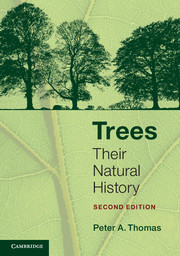Book contents
- Frontmatter
- Epigraph
- Contents
- Preface
- Chapter 1 An overview
- Chapter 2 Leaves: the food producers
- Chapter 3 The trunk and branches: more than a connecting drainpipe
- Chapter 4 Roots: the hidden tree
- Chapter 5 Towards the next generation: flowers, fruits and seeds
- Chapter 6 The growing tree
- Chapter 7 The shape of trees
- Chapter 8 The next generation: new trees from old
- Chapter 9 Age, health, damage and death: living in a hostile world
- Chapter 10 Trees and us
- Further Reading
- Index
- References
Chapter 2 - Leaves: the food producers
Published online by Cambridge University Press: 05 July 2014
- Frontmatter
- Epigraph
- Contents
- Preface
- Chapter 1 An overview
- Chapter 2 Leaves: the food producers
- Chapter 3 The trunk and branches: more than a connecting drainpipe
- Chapter 4 Roots: the hidden tree
- Chapter 5 Towards the next generation: flowers, fruits and seeds
- Chapter 6 The growing tree
- Chapter 7 The shape of trees
- Chapter 8 The next generation: new trees from old
- Chapter 9 Age, health, damage and death: living in a hostile world
- Chapter 10 Trees and us
- Further Reading
- Index
- References
Summary
Perhaps the most striking thing about tree leaves is their tremendous diversity in size. The Arctic/alpine willow (Salix nivalis), which grows around the northern hemisphere, can have leaves just 4 mm long on a sprawling ‘tree’ less than a centimetre high (Figure 2.1a). Smaller still, the scale needles of some cypresses are nearer a millimetre long. Amongst the largest of leaves are those of the foxglove tree (Paulownia tomentosa), which on coppiced trees can be over half a metre in length and width on a stalk another half metre long. Such large sail-like leaves are at risk of being torn by the wind (as in the traveller’s palm – Ravenala madagascariensis; Figure 2.1b) so it is perhaps no surprise that big leaves are usually progressively lobed and divided up into leaflets to form a compound leaf. This can lead to even larger leaves: the Japanese angelica tree (Aralia elata) can have leaves well over a metre in length (Figure 2.1c). Many palms have feathery leaves over 3 m long and in the raffia palm (Raphia farinifera) up to 20 m (65 ft) long on a stalk another 4 m long.
The leaves are the main powerhouse of the tree. Combining carbon dioxide from the air with water taken from the soil they photosynthesise using the sun’s energy to produce sugars and oxygen. These sugars (usually exported from the leaf as sucrose, the sugar we buy in packets) are the real food of a tree. They are used as the energy source to run the tree, and they form the raw material of starch and cellulose and, combined with minerals taken from the soil, allow the creation of all other necessary materials from proteins to fats and oils.
- Type
- Chapter
- Information
- TreesTheir Natural History, pp. 13 - 50Publisher: Cambridge University PressPrint publication year: 2014

